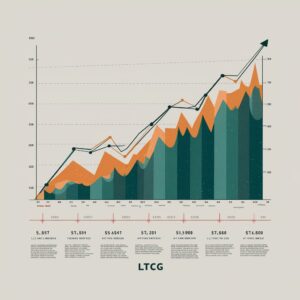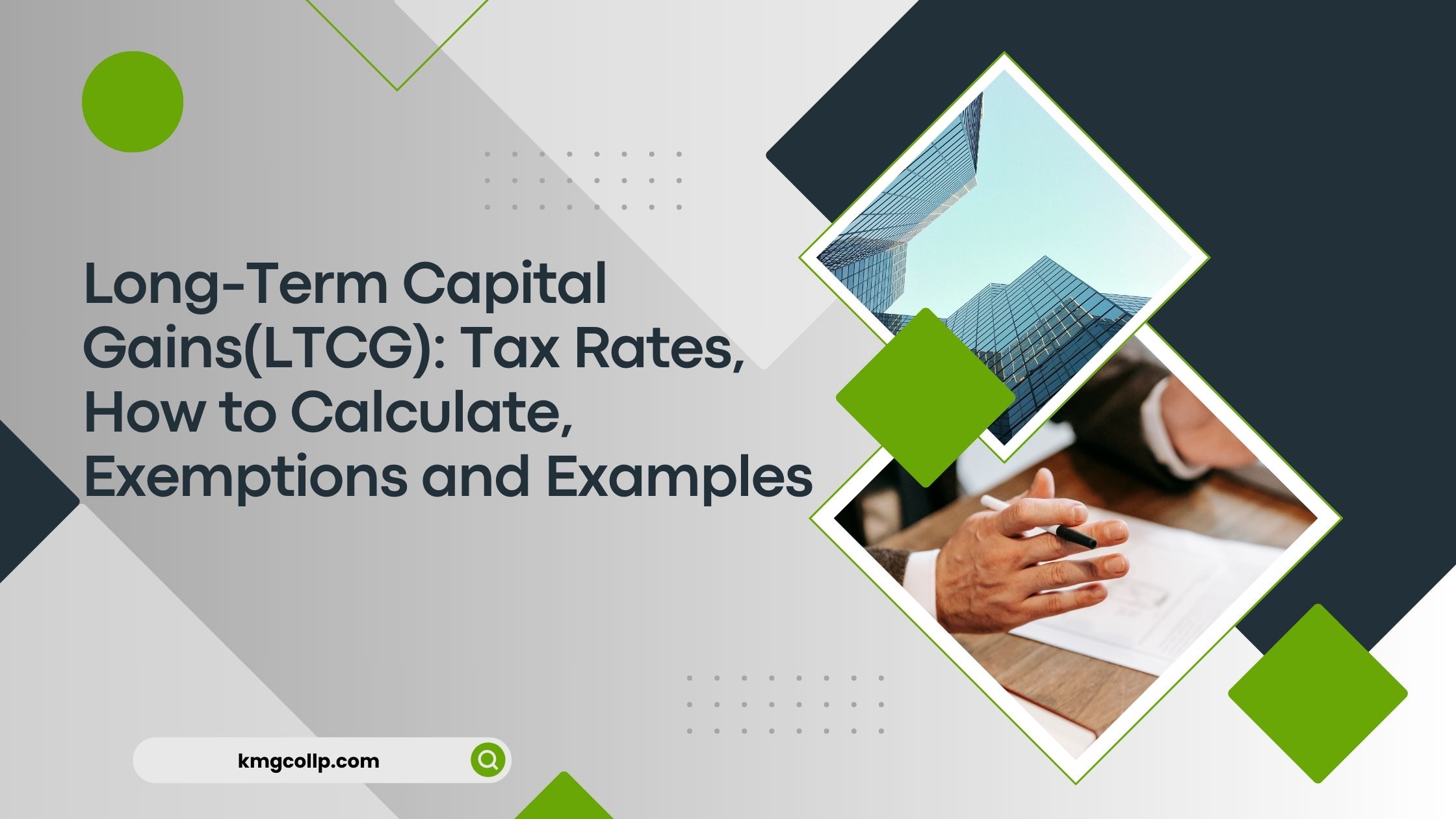Long-Term Capital Gains(LTCG): Tax Rates, How to Calculate, Exemptions and Examples
Profits or gains resulting from the sale or transfer of capital assets, including property, shares, bonds, and vehicles, are taxable under the “Income from Capital Gains” category. Capital assets are classified into short-term and long-term, with long-term capital gains or losses occurring when a long-term asset is transferred.
Budget 2024 Updates
Starting from FY 2024-25, there will be two holding periods: 12 months and 24 months. For listed securities, the holding period will be 12 months, while for all other assets, it will be 24 months. Additionally, the exemption limit for Long Term Capital Gains (LTCG) on the transfer of equity shares, equity-oriented units, or units of Business Trusts will increase from ₹1 Lakh to ₹1.25 Lakh per year. The tax rate on these gains will rise from 10% to 12.5%. For other financial and non-financial assets, the LTCG tax rate will be reduced from 20% to 12.5%, and the indexation benefit on the transfer of other long-term assets will be removed.
However, starting from July 23, 2024, the sale of land and buildings will be taxed at 12.5% without the indexation benefit or 20% with the indexation benefit, based on the taxpayer’s choice if the property was acquired before this date. For properties acquired on or after July 23, 2024, the tax rate will be 12.5% without indexation if they qualify as long-term assets.
Assets are considered long-term if held for more than 24 months, with exceptions for listed securities and equity-oriented funds, which qualify as long-term if held for over 12 months. In this article, we will explore long-term capital gains in depth, covering tax rates, calculations, exemptions, and practical examples.
What is Long-term Capital Gain (LTCG)?

Long-term capital gains refer to profits arising from the transfer of long-term capital assets. The taxation of LTCG is governed by two sections: Section 112 and Section 112A.
- Section 112A applies to the following assets:
- Equity shares in a listed company
- Units of equity-oriented funds
- Units of business trusts
- Section 112 covers all other long-term capital gains not included under Section 112A.

How to Calculate Long-term Capital Gain?
To accurately calculate long-term capital gains, follow these steps:
Step 1: Determine the Full Value of Consideration
This is the total amount received from the transfer of the capital asset, including the monetary payment or fair market value under certain conditions.
Step 2: Determine the Net Value of Consideration
This value is calculated by subtracting any expenses related to the transfer, such as commission or brokerage, from the full value of consideration.
Step 3: Calculate the Cost of Acquisition
Determine the purchase price of the asset. For assets that previously benefited from indexation (like immovable property), the cost of acquisition is adjusted using the Cost Inflation Index (CII) notified by the government annually. The indexation benefit has been removed for transfers made after July 23, 2024.
The formula for calculating the indexed cost of acquisition is: Indexed Cost of Acquisition=Cost of Acquisition×(CII of the Year of TransferCII of the Year of Acquisition)\text{Indexed Cost of Acquisition} = \text{Cost of Acquisition} \times \left(\frac{\text{CII of the Year of Transfer}}{\text{CII of the Year of Acquisition}}\right)Indexed Cost of Acquisition=Cost of Acquisition×(CII of the Year of AcquisitionCII of the Year of Transfer)
Note: The indexation benefit is not available for LTCG taxable under Section 112A.
Step 4: Deduct Exemptions under Sections 54/54B/54D/54EC/54F
Some types of long-term capital gains may qualify for exemptions if specific conditions are met, such as reinvestment in residential property.
Step 5: Calculate Long-term Capital Gains Chargeable to Tax
The formula to determine the taxable LTCG is:
LTCG Chargeable to Tax=Net Sale Consideration−(Indexed Cost of Acquisition+Indexed Cost of Improvement)−Exemptions under Sections 54/54B/54D/54EC/54F\text{LTCG Chargeable to Tax} = \text{Net Sale Consideration} – (\text{Indexed Cost of Acquisition} + \text{Indexed Cost of Improvement}) – \text{Exemptions under Sections 54/54B/54D/54EC/54F}LTCG Chargeable to Tax=Net Sale Consideration−(Indexed Cost of Acquisition+Indexed Cost of Improvement)−Exemptions under Sections 54/54B/54D/54EC/54F
|
Particulars |
Amount |
Amount |
|
Full value of consideration |
xxx |
|
|
Less: Expenses incurred wholly and exclusively for such transfer |
(xxx) |
|
|
Net sale consideration |
xxx |
|
|
Less: Indexed cost of acquisition (Indexation benefit removed for sale made from 23rd July, 2024) |
xxx |
|
|
Less: Indexed cost of acquisition (Indexation benefit removed for sale made from 23rd July, 2024) |
xxx |
|
|
Long-term Capital Gains(LTCG) |
xxx |
|
|
Less: Exemptions under section 54/54B/54D/54EC/54F |
xxx |
|
|
Long-term capital gains chargeable to tax |
xxx |
Long-term Capital Gain Tax Rates
The tax rates for long-term capital gains (LTCG) differ based on the asset type being sold. Below are the applicable rates for various assets:
Listed Equity Shares and Equity-Oriented Mutual Funds:
Starting from July 23, 2024, LTCG exceeding ₹1.25 lakh in a financial year will be taxed at 12.5%. For transfers made before this date, a tax rate of 10% applies.
Other Assets (such as Real Estate, Land, Unlisted Shares, etc.):
- For transfers made on or after July 23, 2024 (excluding land and buildings): LTCG will be taxed at 12.5%, without the benefit of indexation.
- For transfers made on or before July 22, 2024: LTCG will be taxed at 20%, after applying the indexation benefit.
- In the case of land and buildings transferred on or after July 23, 2024: Taxpayers have the option to pay tax at either 12.5% without indexation or 20% with indexation.
Long-term Capital Gain Tax on Shares
Long-term capital gains from shares arise when shares held for more than 12 months are sold. The gain is calculated by subtracting the purchase price from the sale price of shares held for over a year, representing the net profit earned from the sale. For any queries, contact us!
Listed equity shares are considered long-term assets if held for at least 12 months. On the other hand, unlisted equity shares are classified as long-term only if held for at least 24 months.
Long-term Capital Gain Tax on Property
Long-term capital gains on property are realized when a property held for over 24 months is sold. For transfers made before July 23, 2024, the LTCG is taxed at 20% after applying the indexation benefit. For transfers made after this date, the tax rate is 12.5% without indexation.
Additionally, when selling land or buildings after July 23, 2024, taxpayers can choose between paying a 20% tax with indexation or a 12.5% tax without indexation if the property was acquired on or before July 22, 2024.
Example of Long-term Capital Gain Calculation (With Indexation)
Let’s consider an example where John purchased a house in 2005 for ₹20,00,000 and sold it in June 2024 for ₹65,00,000. To calculate the taxable capital gain, we’ll use the Cost Inflation Index (CII), with the index for 2005-06 being 117 and for 2024-25 being 363.
|
Particulars |
Amount |
Amount |
|
Full value of consideration |
65,00,000 |
|
|
Less: Expenses incurred wholly and exclusively for such transfer |
(Nil) |
|
|
Net sale consideration |
65,00,000 |
|
|
Less: Indexed cost of acquisition (20,00,000 * 363/117) |
62,05,128 |
|
|
Less: Indexed cost of improvement |
NIL |
|
|
Long-term Capital Gains(LTCG) |
2,94,872 |
|
|
Less: Exemptions under section 54/54B/54D/54EC/54F |
NIL |
|
|
Long-term capital gains chargeable to tax |
2,94,872 |
Since the sale took place before July 23, 2024, the indexation benefit has been applied in the previous example. As a result, the transfer is subject to a 20% tax rate.
Long-term Capital Gain Example (No Indexation Applied)
John purchased a house in 2005 for ₹20,00,000. He later sold it in August 2024 for ₹65,00,000.
|
Particulars |
Amount |
Amount |
|
Full value of consideration |
65,00,000 |
|
|
Less: Expenses incurred wholly and exclusively for such transfer |
(Nil) |
|
|
Net sale consideration |
65,00,000 |
|
|
Less: Cost of acquisition |
20,00,000 |
|
|
Less: Cost of improvement |
NIL |
|
|
Long-term Capital Gains(LTCG) |
45,00,000 |
|
|
Less: Exemptions under section 54/54B/54D/54EC/54F |
NIL |
|
|
Long-term capital gains chargeable to tax |
45,00,000 |
Since the sale occurred after July 23, 2024, the indexation benefit has not been applied in the above example. Therefore, the tax rate on this transfer will be 12.5%.
How to Report Long-term Capital Gains in ITR-2
To report capital gains in the ITR-2 form, you need to enter the details in the Schedule CG section of Part A. The total capital gains amount will automatically populate in Part B – Total Income, based on the information provided in other schedules.
Long-term Capital Gain Tax Exemptions
The Income-tax Act offers several exemptions that can help reduce the taxable amount of LTCG, provided the capital gains are reinvested in specific assets or instruments. To claim these deductions, certain criteria must be met, and specific conditions must be satisfied to be eligible for these exemptions.
FAQ’s
What is the surcharge on long-term capital gains?
A surcharge applies when your total income exceeds ₹50 lakhs, but for long-term capital gains (LTCG), the surcharge is capped at 15%.
How are long-term capital gains on real estate taxed in India?
Long-term capital gains from real estate, arising from the sale of property held for over 24 months, are taxed at a flat rate of 20% with the indexation benefit for sales made on or before July 22, 2024. For sales occurring on or after July 23, 2024, the applicable tax rate is 12.5% without the indexation benefit.
How much long-term capital gain on listed shares is tax-free?
LTCG on listed shares is exempt from tax up to ₹1,25,000.
Is the basic exemption limit applicable to long-term capital gains?
Yes, the basic exemption limit can be applied to gains from the transfer of long-term capital assets.
Can losses from long-term capital assets be set off against other income?
No, losses from long-term capital assets can only be set off against gains from other capital assets, not against other types of income.
What is the holding period for an asset to qualify as long-term for LTCG?
For most assets, including real estate and unlisted shares, the holding period must exceed 24 months. However, for listed shares and equity-oriented mutual funds, the holding period is 12 months or more.
Are there any exemptions available under Section 54 for LTCG?
Yes, under Section 54, you can claim an exemption on LTCG if the capital gains are reinvested in a residential property within specified time limits.
How is LTCG on unlisted shares taxed?
LTCG on unlisted shares is taxed at 20% with the indexation benefit if the sale is made on or before July 22, 2024. For sales on or after July 23, 2024, the tax rate is 12.5% without indexation.
What is the impact of budget updates on LTCG tax rates?
From FY 2024-25, the tax rate on LTCG for most assets will be standardized at 12.5%, with the indexation benefit being removed for sales occurring on or after July 23, 2024.
Disclaimer: The materials provided herein are for informational purposes only and do not constitute legal, financial, or professional advice. Consult relevant laws and experts before acting on this information. Neither the author nor K M GATECHA & CO LLP is liable for any inaccuracies or omissions. This material is purely educational and not an advertisement or solicitation.
Table of Contents
Toggle



